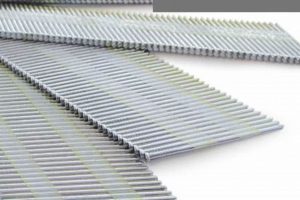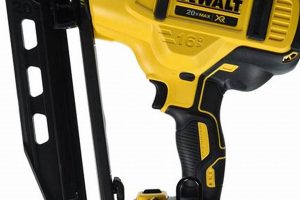This pneumatic tool drives fasteners of a specific diameter, typically used for detailed woodworking. The size of the fastener, indicated by its gauge, influences the application. For example, it might be employed to attach delicate trim or molding where a larger fastener would be visually undesirable or could split the wood.
Such tools offer a balance between holding power and minimal visibility. Their prevalence stems from the need for a reliable method of attaching finishing elements in cabinetry, furniture making, and interior construction. This method allows for efficient and aesthetically pleasing results, a characteristic that has contributed to its continued use and evolution over time.
The subsequent sections will delve into the specific features, selection criteria, and best practices associated with these tools, providing a comprehensive understanding for both novice and experienced users.
Operating a 15 Gauge Finishing Nailer
The following tips offer guidance for safe and effective operation, ensuring quality results and prolonging tool lifespan.
Tip 1: Select Appropriate Fastener Length: Choose fastener lengths appropriate for the combined thickness of the materials being joined. Fasteners that are too long can protrude, while those too short will compromise holding strength.
Tip 2: Adjust Depth Drive Settings: Calibrate the depth drive to set fasteners flush with the surface without damaging surrounding material. Test settings on scrap material before commencing work on the final project.
Tip 3: Maintain Consistent Air Pressure: Ensure the air compressor provides consistent pressure within the tool’s recommended operating range. Fluctuations in pressure can lead to inconsistent fastener placement.
Tip 4: Use Safety Glasses: Always wear appropriate eye protection to guard against ejected debris or errant fasteners.
Tip 5: Hold the Tool Firmly: Maintain a firm and stable grip on the tool during operation to prevent slippage and ensure accurate fastener placement.
Tip 6: Inspect the Work Surface: Examine the material’s surface for knots or grain irregularities. Adjust fastener placement accordingly to prevent splitting.
Tip 7: Lubricate the Tool Regularly: Apply a few drops of pneumatic tool oil to the air inlet before each use to ensure smooth operation and prevent internal component wear.
Proper adherence to these guidelines contributes to efficient workflow, minimizes material waste, and enhances the overall quality of finished projects.
The concluding section will address common troubleshooting scenarios and maintenance procedures to ensure the continued reliability of this tool.
1. Fastener gauge
Fastener gauge, specifically in the context of a 15 gauge finishing nailer, directly determines the diameter of the nail that the tool is designed to drive. The ’15 gauge’ designation signifies that the tool is engineered to accept and effectively utilize fasteners of a specific diameter. Using fasteners outside this gauge specification will lead to tool malfunction, ineffective fastening, or potential damage to both the tool and the workpiece.
The selection of a 15 gauge nailer implies a preference for a balance between holding strength and minimal visibility. Compared to larger gauges, a 15 gauge nail leaves a smaller hole, making it suitable for applications where aesthetics are paramount. Consider, for example, attaching decorative molding or fine trim work, where a larger nail head would be visually obtrusive. In contrast, applications requiring substantial structural support may necessitate a nailer utilizing a lower gauge (thicker) nail.
Understanding the relationship between fastener gauge and nailer type is critical for achieving the desired results. Deviating from the specified gauge presents risks that compromise the integrity and appearance of the finished product. Therefore, adherence to the 15 gauge specification is essential for the correct and safe operation of this type of finishing nailer.
2. Air pressure
Air pressure is a critical parameter in the operation of a 15 gauge finishing nailer. Consistent and appropriate air pressure ensures proper fastener deployment and prevents damage to the tool and workpiece.
- Optimal Operating Range
Each 15 gauge finishing nailer model specifies a recommended air pressure range, typically measured in pounds per square inch (PSI). Adhering to this range is crucial for consistent fastener depth and preventing tool malfunction. Operating below the recommended range may result in incomplete fastener insertion, while exceeding it can cause damage to the internal components of the nailer and increase the risk of blowback.
- Compressor Selection and Regulation
The selection of an air compressor capable of delivering the required PSI is essential. The compressor should possess a regulator to maintain a stable output pressure. Fluctuations in air pressure can lead to inconsistent fastener placement and compromised finishing quality. Periodic inspection and maintenance of the compressor and regulator are necessary to ensure accurate and consistent pressure delivery.
- Hose Length and Diameter
The length and diameter of the air hose connecting the compressor to the nailer can influence the delivered air pressure. Excessively long or narrow hoses can create pressure drops, leading to reduced tool performance. Selecting a hose of appropriate length and diameter minimizes pressure loss and ensures the nailer receives the necessary air volume for optimal operation.
- Adjusting Drive Depth via Air Pressure
While most finishing nailers have a dedicated depth adjustment mechanism, air pressure can indirectly influence the final depth of fastener penetration. Small adjustments within the tool’s recommended pressure range can fine-tune fastener placement, especially when working with varying material densities. However, relying solely on air pressure for depth adjustment is not recommended; the dedicated adjustment mechanism should be the primary method.
Maintaining correct air pressure is fundamental to the proper functioning and longevity of a 15 gauge finishing nailer. Careful attention to compressor selection, pressure regulation, hose selection, and adherence to the tool’s specifications contribute to consistent and professional finishing results.
3. Depth Adjustment
Depth adjustment is a critical feature integrated into 15 gauge finishing nailers, directly influencing the precision and quality of the finished product. Its function extends beyond mere aesthetics, impacting the structural integrity of the fastened joint and preventing surface damage.
- Mechanism Variability
Depth adjustment mechanisms vary across different models of 15 gauge finishing nailers. Some utilize a simple dial or knob, offering incremental adjustments, while others employ more complex, tool-free systems for rapid and precise setting changes. The chosen mechanism affects the ease and speed with which the user can adapt to varying material densities and fastener lengths. The presence of a visible indicator or scale on the adjustment mechanism enhances accuracy and repeatability.
- Material Density Considerations
The density of the material being fastened dictates the necessary depth setting. Softer woods, such as pine or cedar, require a shallower setting to prevent the fastener from penetrating too deeply and marring the surface. Conversely, denser hardwoods, like oak or maple, necessitate a deeper setting to ensure secure and flush fastener placement. Failure to adjust the depth appropriately can result in protruding fasteners, unsightly indentations, or weakened joints.
- Fastener Length Correlation
The length of the 15 gauge fastener being used also influences the optimal depth setting. Longer fasteners require a deeper setting to ensure complete and secure penetration into the underlying material. Conversely, shorter fasteners demand a shallower setting to prevent over-driving and potential damage. The interplay between fastener length and depth adjustment is crucial for achieving a clean and professional finish.
- Preventing “Over-Driving” and “Under-Driving”
The primary function of depth adjustment is to prevent both “over-driving,” where the fastener sinks too deeply into the material, leaving an undesirable mark, and “under-driving,” where the fastener protrudes above the surface, creating a potential hazard and detracting from the aesthetic appeal. Accurate depth adjustment ensures the fastener is set flush with the surface, providing a clean and professional finish that meets both aesthetic and structural requirements.
The ability to precisely control fastener depth within a 15 gauge finishing nailer is not merely a convenience; it is a necessity for achieving professional-grade results. Proper utilization of the depth adjustment mechanism enhances the tool’s versatility, allowing it to be effectively employed across a range of materials and applications while minimizing the risk of surface damage and ensuring the long-term integrity of the finished product.
4. Wood type
The selection of wood type is intrinsically linked to the effective utilization of a 15 gauge finishing nailer. The characteristics of the wood influence fastener selection, depth adjustment, and overall project outcome.
- Density and Hardness
Wood density and hardness directly impact fastener penetration. Softer woods, such as pine or fir, require lower air pressure and shallower depth settings to prevent overdriving and surface damage. Harder woods, including oak or maple, necessitate higher pressure and deeper settings for secure fastener placement. The tool’s adjustable settings must be calibrated to match the specific wood’s resistance.
- Grain Direction
Grain direction influences splitting susceptibility. Nailing parallel to the grain increases the risk of splitting, particularly near edges. Pre-drilling pilot holes may be necessary when working with woods prone to splitting, regardless of the finishing nailer’s gauge. Careful fastener placement, avoiding knots and irregularities, minimizes the likelihood of grain-related issues.
- Wood Stability and Movement
Wood is a hygroscopic material, expanding and contracting with changes in humidity. This movement can stress fastener connections over time. Choosing appropriate fastener lengths and considering the wood’s expansion coefficient can mitigate potential issues. Flexible adhesives used in conjunction with fasteners can also accommodate minor wood movement.
- Wood Species and Finishing
Different wood species exhibit varying levels of acceptance to finishes. The small entry hole left by a 15 gauge nailer minimizes visual impact, but careful filling and sanding may be required for certain woods to achieve a seamless finish. The chosen finish should be compatible with the wood type and the filler used to conceal nail holes.
Understanding the interplay between wood characteristics and the capabilities of a 15 gauge finishing nailer is crucial for achieving durable, aesthetically pleasing results. Proper wood selection and preparation, combined with appropriate tool settings, ensure successful and long-lasting woodworking projects.
5. Applications
The utility of a 15 gauge finishing nailer is determined by the specific tasks it is designed to perform. The gauge of the nail dictates the balance between holding power and minimal visibility, resulting in a tool suited for applications where aesthetics are paramount. The choice of this particular nailer is a direct consequence of the project requirements, influencing the outcome in terms of both structural integrity and visual appeal. For example, in the installation of delicate crown molding, a 15 gauge nailer provides sufficient holding strength without creating excessively large nail holes that would require extensive filling and sanding. This contrasts with heavier-duty applications where a larger gauge nailer would be necessary to ensure structural stability.
Further examples of suitable applications include cabinet making, specifically attaching face frames and decorative trim. The relatively small diameter of the 15 gauge nail minimizes the risk of splitting the wood, especially when working with hardwoods. Similarly, in furniture construction, this nailer is effective for securing joints and attaching decorative elements where a less conspicuous fastener is desired. The effectiveness of the 15 gauge finishing nailer is, however, limited by the materials being joined and the stress they will endure. Load-bearing joints or exterior applications typically require stronger fasteners and may necessitate alternative tools.
In summary, the selection of a 15 gauge finishing nailer is driven by the specific demands of the task at hand. Its suitability for applications requiring a blend of holding power and minimal aesthetic disruption makes it a valuable tool for finish carpentry and detailed woodworking. Challenges arise when attempting to use it beyond its intended scope, underscoring the importance of understanding the tool’s limitations and selecting appropriate alternatives for more demanding applications. The connection between specific applications and the 15 gauge finishing nailer highlights the importance of tool selection in achieving optimal results.
6. Maintenance
Regular maintenance is a critical factor in ensuring the longevity and optimal performance of a 15 gauge finishing nailer. The tool’s pneumatic operation and intricate internal mechanisms are susceptible to wear and tear, requiring consistent upkeep to prevent malfunctions and maintain consistent fastening quality. For instance, inadequate lubrication can lead to increased friction, causing premature wear of internal components such as O-rings and pistons. This, in turn, can result in air leaks, reduced driving power, and ultimately, tool failure. Similarly, neglecting to clean the nailer can allow dust and debris to accumulate, obstructing the firing mechanism and leading to misfires or jams. Real-world examples frequently demonstrate that consistent maintenance routines, such as daily lubrication and periodic cleaning, significantly extend the operational lifespan of these tools.
The practical significance of understanding the maintenance requirements extends beyond preventing outright tool failure. A properly maintained 15 gauge finishing nailer delivers consistent and accurate fastening results, reducing the likelihood of rework and material waste. For example, consistent lubrication ensures that the driving mechanism operates smoothly, preventing the nail from being driven too deep or too shallow. This is particularly important in finish carpentry, where aesthetics are paramount. Furthermore, preventative maintenance reduces the risk of unexpected downtime, allowing users to complete projects on schedule and minimize disruptions. A regularly serviced tool also poses a reduced safety risk, as malfunctions are less likely to occur, potentially preventing workplace injuries. The application of specific maintenance protocols also has a cause and effect correlation. The more diligently you treat the tool, the longer it lasts.
In conclusion, maintenance is not merely an ancillary aspect of owning a 15 gauge finishing nailer; it is an integral component of ensuring its reliable operation and maximizing its lifespan. Challenges in implementing effective maintenance practices often stem from a lack of awareness or a failure to adhere to recommended procedures. However, by understanding the connection between regular upkeep and tool performance, users can mitigate these challenges and reap the benefits of a consistently functioning and durable tool, ultimately leading to improved project outcomes and reduced long-term costs.
Frequently Asked Questions
This section addresses common inquiries regarding the selection, operation, and maintenance of 15 gauge finishing nailers. The information presented aims to clarify technical aspects and promote informed decision-making.
Question 1: What distinguishes a 15 gauge finishing nailer from other types of nailers?
The designation “15 gauge” refers to the diameter of the nails the tool is designed to use. This gauge provides a balance between holding power and minimal visibility, making it suitable for finish carpentry and detail work. Other nailer types, such as framing nailers, utilize larger gauge nails for structural applications.
Question 2: Is a specific air compressor required for operating a 15 gauge finishing nailer?
Yes, an air compressor capable of delivering the pressure within the nailer’s specified operating range is necessary. The compressor must possess a regulator to maintain consistent pressure, typically between 70 and 100 PSI. The compressor’s tank capacity should be sufficient to handle the nailer’s air consumption rate.
Question 3: How is nail depth adjusted on a 15 gauge finishing nailer?
Most 15 gauge finishing nailers feature a depth adjustment mechanism, typically a dial or knob, that allows the user to control the depth to which the nail is driven. Proper adjustment ensures the nail is flush with the surface without damaging the surrounding material.
Question 4: What types of wood are suitable for use with a 15 gauge finishing nailer?
A 15 gauge finishing nailer is appropriate for a range of wood types, including softwoods and hardwoods. However, the density of the wood dictates the necessary pressure and depth settings. Softer woods require lower pressure to prevent overdriving, while hardwoods may necessitate higher pressure for secure fastening.
Question 5: How often should a 15 gauge finishing nailer be lubricated?
Regular lubrication is essential for maintaining optimal performance. Applying a few drops of pneumatic tool oil to the air inlet before each use is recommended. Periodic disassembly and cleaning of internal components may also be necessary to remove accumulated debris.
Question 6: What safety precautions should be observed when operating a 15 gauge finishing nailer?
Safety glasses must be worn at all times to protect against ejected debris. The tool should be held firmly and directed away from oneself and others. Disconnecting the air supply when not in use is crucial to prevent accidental firing.
These FAQs provide a foundational understanding of 15 gauge finishing nailers. Understanding the underlying principles and correct application of a 15 gauge finishing nailer will promote professional results.
The following section will provide some specific recommendations on models of 15-gauge finishing nailers.
Concluding Remarks on the 15 Gauge Finishing Nailer
This exploration has outlined the essential characteristics, operation, and maintenance of the 15 gauge finishing nailer. Its suitability for detailed woodworking, balancing holding power with minimal aesthetic impact, has been emphasized. Factors such as fastener selection, air pressure regulation, depth adjustment, and material compatibility have been presented as critical determinants of performance and longevity.
Effective utilization of the 15 gauge finishing nailer demands a comprehensive understanding of its capabilities and limitations. Continuous adherence to safety protocols and recommended maintenance procedures is paramount for ensuring both operator safety and the extended operational lifespan of the tool. Further exploration of advanced techniques and evolving technologies within the field of pneumatic fastening is encouraged for professionals seeking to optimize their craft and maximize the potential of this specialized tool.







